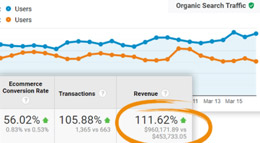2025 eCommerce SEO Strategies & Best Practices
Ecommerce SEO is more important for eCommerce websites than ever before. A strong eCommerce SEO strategy is crucial for maximizing organic visibility in search engines, outranking competitors in the search results, and maximizing the number of new customers coming organically from Google and other major search engines.

Since organic traffic remains one of the most viable sources of revenue for an eCommerce site and drives around 33% of traffic, businesses benefit significantly from investing the appropriate resources into an eCommerce-focused SEO campaign.
Most eCommerce sites utilize SEO in some capacity, whether managed and performed in-house or by an SEO agency. More times than not, those who are winning in Google are the ones that take search engine optimization seriously and respect the potential impact of utilizing – or not utilizing – eCommerce SEO for their online store.
But not all SEO agencies are created equal, and only a handful focus on eCommerce. As one of the pioneering web companies to offer eCommerce SEO services, OuterBox has gained incomparable skills and knowledge about search engine optimization. We’ve learned exactly what it takes to successfully rank in Google and increase organic traffic and revenue. We’ve worked on hundreds of eCommerce sites in a variety of industries and eCommerce SEO is our passion. We help eCommerce websites grow their organic (and paid) traffic/revenue from Google and other search engines every day.
This comprehensive guide shares many of our best eCommerce SEO strategies, techniques, and tactics. From eCommerce keyword research and on-page optimization to link building and other off-page tactics, we’ll inform you on all things eCommerce SEO and you’ll be ready to make better marketing decisions for your online store.
Understanding Keywords: What's in a Keyword?
When it comes to SEO, a keyword is just a fancy term for a search query. This is true for eCommerce SEO, too.
Anything that is entered and searched on a search engine is a keyword. Keywords may be comprised of one word, a phrase, a question, etc. Anything that anyone has ever typed into a search engine is a keyword.

For example, “guitars,” “guitars for sale,” and “used 1970s Gibson guitars for sale” are three distinct keywords. Each would be relevant for an eCommerce site that sells guitars. But if they don’t offer Gibson guitar from the 1970s, that third keyword is not optimal for their eCommerce site.
eCommerce Product Pages and Category Pages usually have distinct keywords. “Nike Air Max Shoes” would be great for a product page, and “Nike Basketball Shoes” would make sense for its category page. Different eCommerce industries or niches often have distinct ways of searching. B2B industries often use product SKUs. Big Brands like Nike or Adidas will have a lot of important branded keywords, such as “Adidas running shoes,” or “Nike cleats.”
Think like your potential customer would think and consider the psychology of search when researching new keywords. Sometimes keywords consist of a phrase or words strung together and are considered long-tail keywords.
Long-tail keywords are usually lower competition than their shorter counterparts and represent a great opportunity for eCommerce sites with low domain authority or attempting to rank in competitive search results pages. An up-and-coming mattress company might have an easier time seeing page one rankings for the keyword “luxury king size mattress innerspring” than “mattresses.” Pursuing long-tail keywords is an extremely viable SEO tactic, especially for eCommerce sites. Content marketing strategies love long-tail keywords! Information keywords that are relevant to your products are great for content marketing and often include longer-tail keywords.
- Google Search Console, and Google Analytics, can provide you with information about your organic visibility in search, how many clicks and impressions your pages get in the search results, and what keywords or search queries your eCommerce site ranks for. Using a Google Search console account is essentially mandatory for SEOs and webmasters to keep a pulse on how Google perceives their eCommerce sites.
- Professional SEO software, independent tools, and organic ranking trackers can quickly tell you what any website ranks for in Google, which is a great place to start finding relevant, qualified search terms to expand upon.
SEO professionals have access to myriad tools that aggregate data for all of the keywords that are ever searched. Google and other search engines provide invaluable information about any potential keyword you can imagine, including:
- Average monthly search volume
- Average cost-per-click of that keyword via paid ads / PPC
- How competitive that keyword is, or how difficult it would be to rank on page one
The first step in any SEO campaign, whether SEO for eCommerce or otherwise, is to develop a list of keywords that are relevant to your website that you wish to rank for. Where do you want to see your website in the search engine results?
If the goal of SEO is to improve your website’s ability to rank in search engines, you need to know what keyword rankings you want to improve. Pick a list of a few hundred keywords you want to start improving your website’s ranking for, and you’ve just put together your first keyword list!
Make sure to have one primary keyword and a few ancillary keywords picked out for your top 50-100 pages or so, including your top blog post pages, product pages, and category pages. Product pages and category pages are usually your most important pages with eCommerce sites, so having relevant keywords in mind for those pages is essential.
Google Keyword Planner tool provides a direct source of keyword information. Google Keyword Planner data is utilized via API and further extrapolated upon by a variety of SEO tools. These tools facilitate your research in an intuitive platform.
With industrial-grade SEO software, you can do things like analyzing the keyword rankings of each website ranking on page one of Google for search terms (keywords) from your initial keyword research to uncover even more possibilities.
With lots of category and product pages, it’s easy to collect hundreds or thousands of relevant keywords for an eCommerce site. Exporting your keyword data into spreadsheets to compile and process your keywords into an organized list is a great way to identify the keywords that you can later develop strategies around to improve your rankings. SEO for eCommerce requires ongoing research and analysis to improve and maintain keyword rankings.
Your keyword list will support other SEO strategies and tactics, such as the URL structure, naming convention of categories and products, data imports, website hierarchy, structure, etc.
Once you know what keywords you want your eCommerce site to rank for, you can also start determining how hard it would be for your webpages to rank for those Google searches. Keyword difficulty is a metric provided by the various tools, but you can usually use CPC for paid ads to get a good idea.
Understanding how competitive the search results pages are for each keyword you intend to target (keyword difficulty) is one of the first steps in determining an appropriate budget/allotment of resources for SEO for eCommerce sites.
Keyword Research: The Foundation of Your eCommerce SEO Strategies
Understanding the totality of potential search queries new customers could use to find your store is crucial.
Your initial keyword list is the foundation that you will use to build your SEO campaign. You will always be thinking of new keyword opportunities. It’s also an ongoing process, especially as new products and pages are added to your store. Any new page will likely require some fresh research since search trends in Google are constantly changing. Google Keyword Planner and other tools provide SEO professionals with all the keyword data needed.
Here’s how to find the best keywords for your business and how to uncover keywords that even your top competitors miss out on.
With an eCommerce site, your main objective is to find keywords with inherent eCommerce intent.
Every keyword has an intangible quality referred to as search intent. What is the typical searcher looking for when they enter a given keyword into a search engine? Is this person looking for an online store? Google relies heavily on advanced AI algorithms to answer these questions and deduce search intent algorithmically for any keyword.
Search Intent & eCommerce SEO
Search intent represents the theoretical information the searcher wishes to obtain or the objective the searcher wants to accomplish as a result of their query. Things to consider include:
- Is the searcher looking for eCommerce product pages?
- A category page?
- A buying guide or article?
Think, if someone searches “x” term, what type of content would they want? Also, search the term on Google and see what Google is serving up. If you’re trying to rank a product page for a term that Google displays all categories, chances are your search intent is wrong (or at least Google thinks so, and in the end, that’s all that matters, right?) SEO for eCommerce is all about understanding search intent, identifying relevant keywords with eCommerce intent, and improving your site’s search engine rankings for those relevant keywords.
With that in mind, all research must consider the search intent of the keywords before deciding to target them. For researching keywords for eCommerce sites, you’ll want to look for eCommerce intent. Identifying the right keywords and long-tail keywords with eCommerce intent is vital to building a strong eCommerce SEO strategy.
In other words, look for some qualifying factor(s) about the keyword that means this person is looking to purchase a product. Otherwise, you could end up driving traffic that, in the end, is worthless (meaning it doesn’t lead to significant increases in transactions or revenue).
Example Time!
Let’s say your eCommerce website sells used guitars. An excellent place to start your keyword research is with broad keywords that describe your products or services. Let’s start by plugging in “used guitars” into a keyword research tool. The screenshot below is from Ahrefs.com.
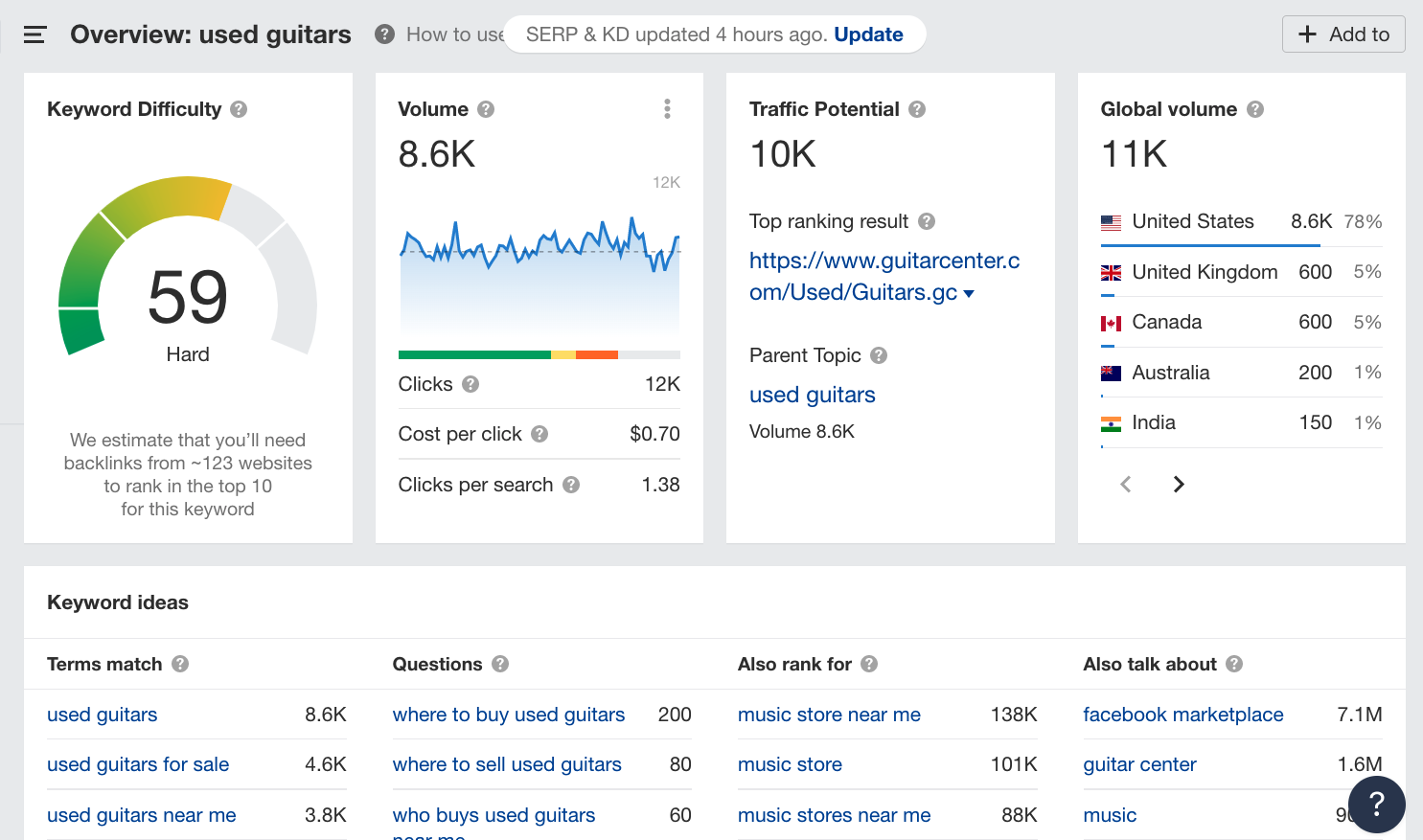
While the keyword “used guitars” has a much higher search volume, “used guitars for sale” has eCommerce intent. You would also want to consider targeting “used guitars near me “, but note the search volume is lower than “used guitars for sale.” The searcher is looking for used guitars that are for sale near them, so this means they are more likely looking for a local retailer than an online store. Someone who searches for the broader “used guitars” might just be looking for information or pictures of used guitars with no impending intent to purchase. All of these keywords are still relevant, and worth targeting if you sell used guitars, it’s just a matter of where, when, and how. Informational keywords are great for content marketing and supporting your primary eCommerce keywords.
Keywords don’t have to have words like “buy” or “for sale” to have clear eCommerce intent.
There are many other indicators that a keyword has eCommerce intent:
- Product SKUs – if someone searches for a product SKU, they are likely looking to purchase the product unless the searcher includes another qualifier like “repair” in the query.
- Dimensions / Sizes – if someone searches for “case of 16 oz ketchup bottles” they’re likely not looking for a blog article to satisfy their query, they want to buy some ketchup!
- Naked, branded product names can go either way, but are worth targeting for eCommerce websites. Someone searching for “MacBook Pro” might want to buy one, or might just want to read the Wikipedialess page on MacBook Pros.
- Many other factors! Use your head and put yourself in the mind of the potential searcher.
There are ways to sort and filter your keyword data in ways that help you find the keywords with eCommerce intent quickly, organize all of them into a spreadsheet, and refine down to a list of the ones you want to focus your SEO campaign on improving.
We’ll tell you exactly how later, but for now, let’s discuss the many different research tools that a digital marketing agency have at their disposal and how to use them to drive more organic traffic!
The Best Keyword Research Tools for eCommerce SEO
- Ahrefs
- Moz
- SEMRush
- Keywords Everywhere
- Amazon.com’s Search Suggest Functionality& https://www.keywordtooldominator.com/
- Google Keyword Planner (many tools utilize Google Keyword Planner data)
Lesser-Known / Niche Keyword Tools
Today’s eCommerce SEO tools make keyword research a lot easier than it used to be, but that doesn’t mean it is any more straightforward. With so many tools available, it’s easy to get lost in a sea of keywords.
Let’s take a look at some of the basic options you have for keyword research with the popular SEO tool Ahrefs.com.
1. Start with a basic idea for what you want the page you are researching keywords for to rank.
For this example, let’s imagine we are optimizing a product page for Audio-Technica brand headphones, model M70x. You can begin your research the same way you might start your own Google search. You can also put a list of hundreds of keywords in this tool to get ideas and related keywords for hundreds of keywords simultaneously.
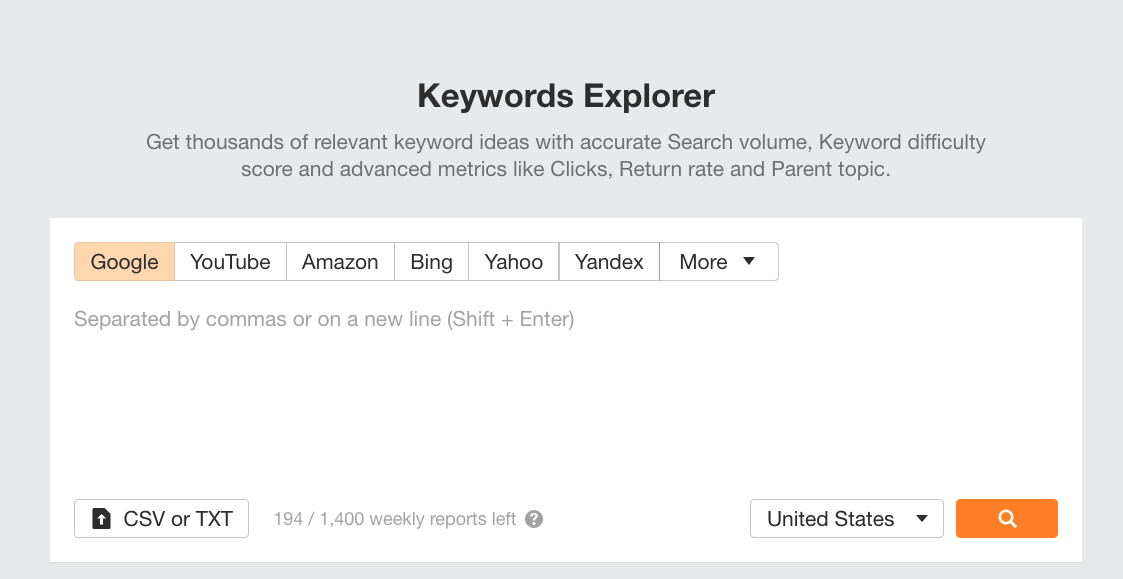
2. Review the Keyword's Overview Data and Find Your Keywords!
We typed in “audio technica m70x” into the tool. Below, you can view the data provided for each keyword, view other keywords with the same terms, review related questions, etc. All of these options will help you uncover new and potentially better keywords to target. That related question, “why no love for the audio technica m70x” would be a great blog topic to help support your product page. Create a blog that discusses why there is no love for these headphones and use the blog as a sales tool to funnel readers to your product page. Incentivize with a coupon code on the blog page to increase conversions.
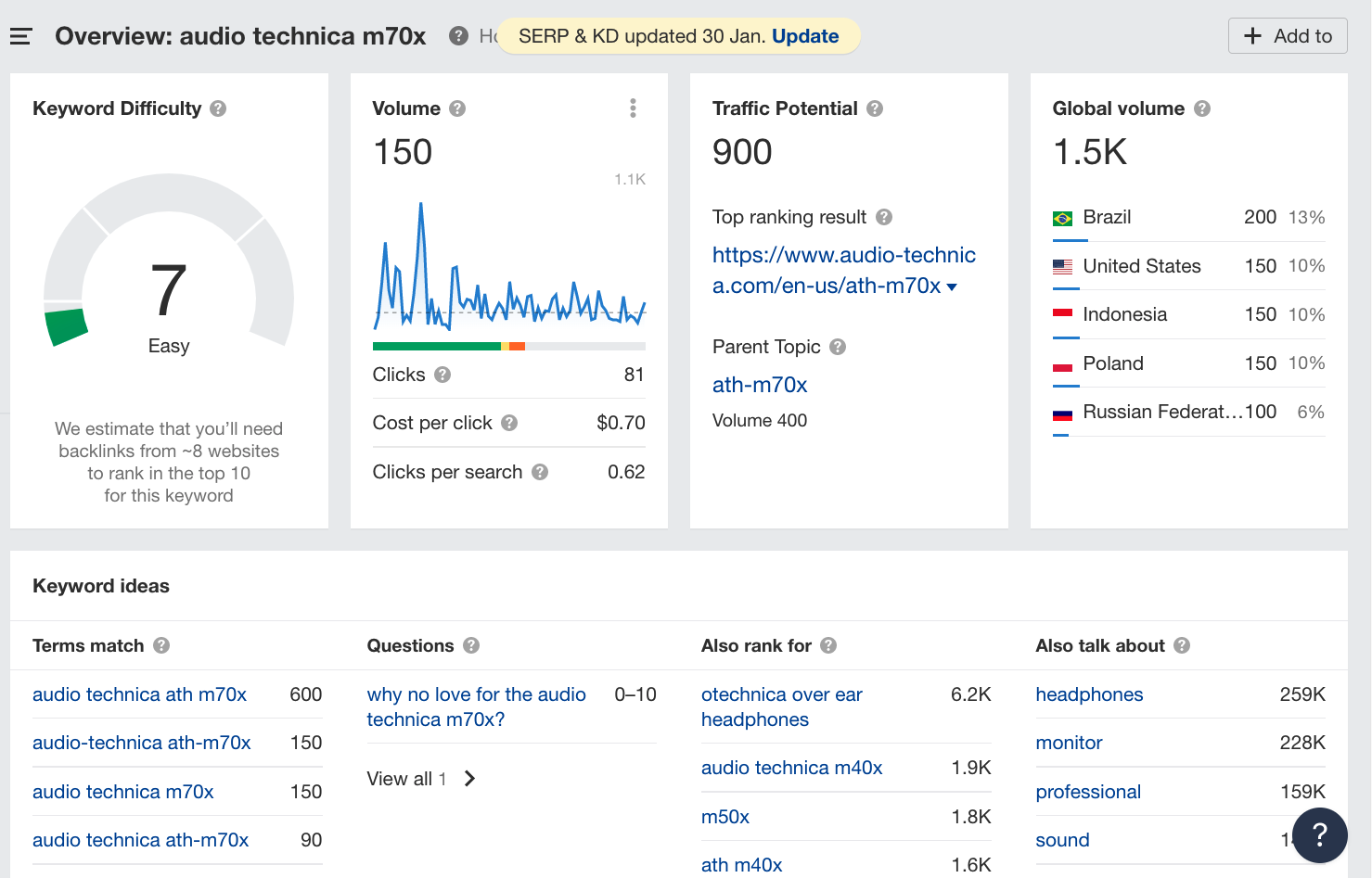
Here, you can view metrics for your keyword, view other keywords with the same terms, review related questions, etc. All of these options will help you uncover new and potentially better keywords to target.
3. Be sure to review suggested keyword ideas, parent topics, keywords having the same terms to make sure you find the best keyword(s).
Just from viewing the related terms, you can already realize that the keyword “audio technica ath-m70x” gets searched nearly double our initial keyword idea of “audio technica m70x.” Assuming the same eCommerce intent, which would you choose to target?
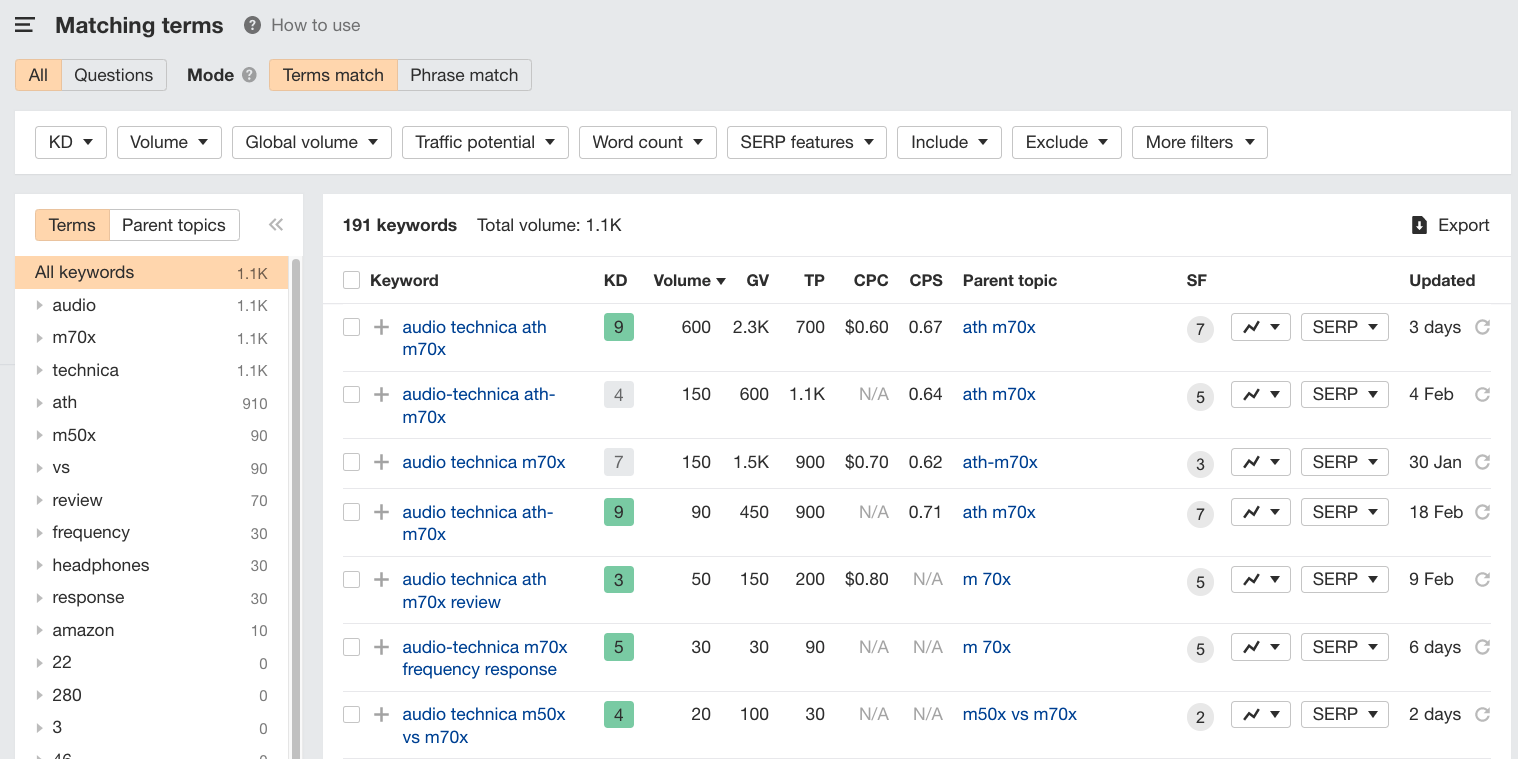
4. Use Several Tools
You’ll want to use several tools, to compare data, and make sure that you don’t miss any potential keywords. While tools like Ahrefs and SEMRush have a myriad of valuable information for SEO professionals, the data is often “estimated” and so you will have some discrepancies from tool to tool. Understanding the strengths and weaknesses of each tool is something that only comes with time and experience. Below, SEMRush’s keyword overview data for the same “audio technica m70x” keyword we researched in Ahrefs.com earlier. Note that SEMRush estimates 260 monthly searches compared to Ahrefs 250 estimation.
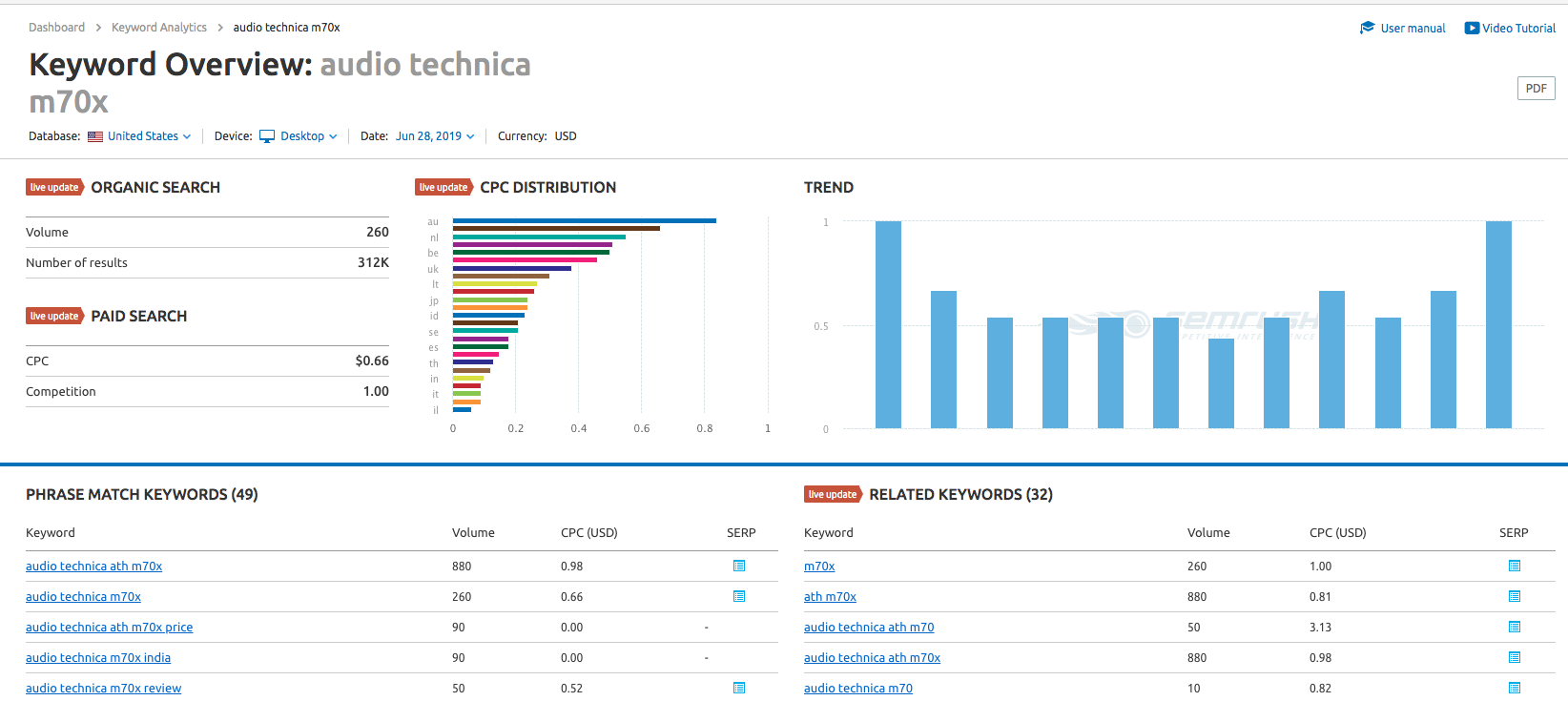
Category Keyword Research
- Research Tools (as outlined above)
- Amazon – study how they structure similar categories and subcategories and which keywords they target. You can decide to target the same as Amazon or go after longer-tail variations, but use Amazon to get a quick big-picture understanding of potential keywords.

- Competitors- Using a tool like Ahrefs.com, you can easily see all of the keywords a domain ranks for. Study what keywords your
competition targets, and use their list as a foundation for your research. - Other online sources that may display the natural hierarchy of the subject, Wikipedia, for example.
- Common sense + search volume, intent, CPC, difficulty
Researching Keywords for Product Pages
Use the same sources as you would use above for categories. Target product-specific keywords, SKU, etc., instead of broad “category” type keywords like “red cars”
Choosing Keywords
- Common sense + search volume, intent, CPC, difficulty
- Search Volume
- Relevancy / Accuracy
- Commercial Intent
- Unique Potential: High Revenue Potential
- Competition
- Short tail vs. long tail
On Page Optimization For eCommerce SEO
On-page optimization refers to developing, formatting, and structuring the copy and other on-page elements (most notably title tags, meta descriptions, and headers) of your web pages in an attempt to improve their ability to rank for your keywords.
Many people like to start the on-page optimization process by developing a master keyword list of anywhere from ten to several hundred keywords to target sitewide. Depending on the scope of your planned SEO work, this may or may not be worthwhile.
Before optimizing a given web page, you’ll want to have a focus keyword and some keywords related to that focus keyword in mind, as well as LSI terms and other qualifiers commonly associated with your target keywords. Incorporating these terms strategically helps you improve your search results. Since your title and meta descriptions and URL show up in the search results they should be crafted to rank well and entice clicks.
For example, on a product page for Fender Stratocasters, your focus keyword might be “fender stratocasters for sale”, and a secondary keyword might be “where to buy a fender strat”. LSI terms could be words like “amplifier”, “electric”, “strings”, etc.
eCommerce Qualifiers
Including eCommerce qualifiers (both in your keyword research processes as well as in your page copy) like “buy” and “for sale” is also beneficial to cast as wide a net as possible and give Google more information to digest.
If you do choose to make a master keyword list for your eCommerce site, you’ll want to make sure you set aside target and secondary keywords for all of your most important pages. Your homepage, category pages, product pages are most critical on an eCommerce site. Blog pages are valuable for eCommerce sites, but you’ll probably want to do independent keyword research when coming up with new ideas for content or developing a content plan.
For beginners, the actual keyword research process itself can sound intimidating, but with powerful SEO keyword tools like Ahrefs.com and SEMRush.com at your disposal, a lot of the leg work is done automatically. Let’s walk through a couple of basic real-world examples of how to begin keyword research for an eCommerce page, whether optimizing product and category pages, your homepage, etc.
The very first step of keyword research is to consider what terms you want your website to rank for when plugged into a Google search.
Theoretical Example
Regardless of whether you’re optimizing a product page or a category page, your on-page optimization will involve the same types of elements:
- Page Title Tags(title tag optimization being crucial for home page, category pages, and product pages)
- Meta Descriptions
- H1 (one per page!)
- Other tags (h2, h3, h4, etc.) can be used as frequently as needed. The lower the number, the more attention Google will pay to your header. So, apart from H1s, H2s get the most “SEO weight”. H1s and title tags should work together as the basis for on page SEO for each page you work on. Make sure the title tag, headers, and h2s incorporate your keywords.
- Structured Data
- Images (add descriptive keyword-rich alt text, include keywords in your image file name, and optimize your image file sizes for the web.)
- Copy & On-Page Content
- Many more…these are the basics!
Ahrefs Keyword Tool Quickly Provides Keyword Ideas
Let’s say we have a product page that sells the Gibson L5-S Guitar. You’ll want to focus on the keyword “Gibson L5S for sale,” because it has eCommerce intent. Of course, you’ll still be targeting “gibson l5s” indirectly, but it would be more valuable to rank for the keyword with eCommerce intent. There are also informational keywords that might not have eCommerce intent but would be great for use in content marketing, blogs, etc. Informational keywords should be related to your primary keywords and support your top converting product pages and categories.
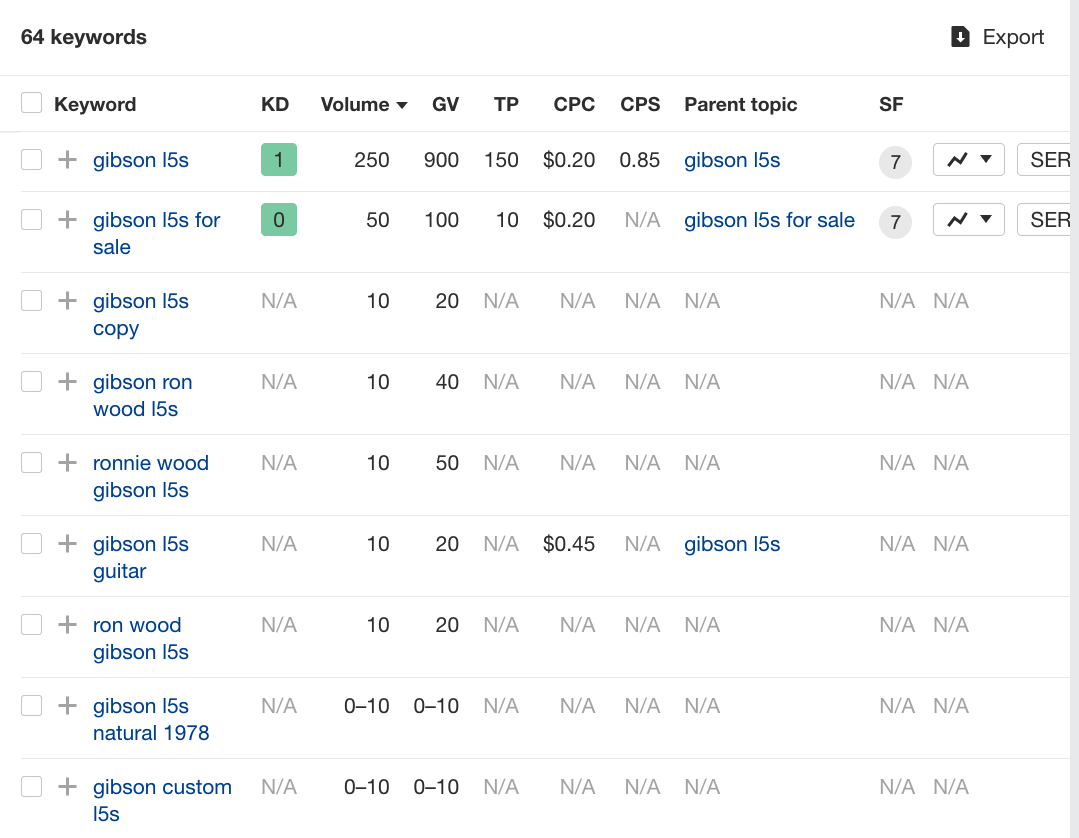
Below, is a screenshot of what a basic HTML file would look like with some on-page optimizations in place for the keywords “gibson l5s for sale”, “gibson l5s” and ” gibson l5 custom”. Notice that we are using the keywords naturally and not stuffing them everywhere.
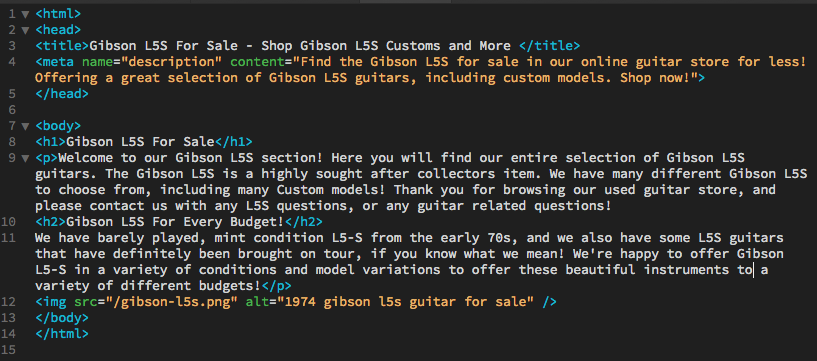
It’s important to realize that you don’t want to stuff keywords in your title tag or have your on-page copy seem spammy or written solely for search engine robots, or it won’t rank and conversions will be abysmal. The above example is a high-level example of what the HTML elements for on-page optimization can look like in the source code. Of course, your HTML code will likely be full of all sorts of other code, JavaScript, etc.
Boost Store, Category, and Product Rankings With Unique & Engaging Product Descriptions
One of the most basic but often overlooked eCommerce strategies, writing unique product descriptions that strengthen your brand, engage your audience, and educate your shoppers will set your eCommerce site apart from your competitors in a way that is meaningful for both search engines and your customers.
Excellent product page copy is even more valuable if you are selling products that can be found on hundreds of other eCommerce sites, since many of these stores will copy and paste a product description right from the manufacturer, resulting in thin and duplicate content across dozens of sites or more. Whether your products are available elsewhere or you’re the only supplier, writing unique and engaging product descriptions, optimized with your target keywords, will increase your organic rankings. If done well, it will do this while simultaneously improving your conversion rate.
Target Long-Tail Keyword Variations in Blog Articles and Content
Content still reigns supreme and is a key component of eCommerce SEO in 2025. For the best eCommerce SEO, your blog post strategy should leverage long-tail keyword variations of your target keywords for products and categories. These should include product reviews, how-to articles, etc. If you sell running shoes, you should write articles about running, jogging, how to pick running shoes, etc. Use internal links so these resources can enhance your product pages, too.
Prioritize Store Navigation
User experience is still a hugely overlooked aspect of today’s eCommerce stores. Focus on creating an easy-to-navigate website, especially on mobile. Carve the path of least resistance from the home page to checkout.
This will just only help your conversion rate but should improve your organic visibility as well. Google pays attention to whether or not a user bounces back to the search engines after visiting your site, and usability and site navigation plays a huge role here. If you earn keyword rankings in Google but all of that traffic heads back to Google to find a better website, Google will assume your website isn’t an ideal place to send traffic. If you want to give your eCommerce SEO campaign a boost, find a way to decrease your bounce rate.
Add Internal Links to Relevant Products, Categories, and Resources
Creating internal links within your site’s on page SEO copy is misconstrued to be an outdated strategy, but it is still incredibly effective and worthwhile. Focus on placing relevant internal links throughout on page copy and articles for humans, not for search engines, and your site will thank you. As long as you’re not keyword stuffing or placing irrelevant internal links, internal linking throughout your site is a natural way to help Google understand your website and content that much better. Internal links should use anchor text that incorporates keyword ideas from your keyword list and be similar to the keywords in that page’s title tag.
Structured Data for eCommerce Websites
Ever wonder why some results in Google seem to have more information than others? For example, have you searched for a product and noticed some product pages display star ratings for reviews right in the search results? These enhanced results are usually the result of the webmaster implementing structured data on product pages and category pages. This is a great way to enhance CTR for eCommerce websites.

Structured Data will not only help enhance your listings, and can also help you get those featured results and callouts in the SERPs.
Structured data is computer code that has been formatted specifically to improve a search engine’s ability to understand the content of the page. While the information itself is usually displayed on the page for the user, the actual marking up of specific elements is done behind the scenes in the source code of any given webpage. Structured data refers to marking up specific elements on the page as “rich” data for search engines to digest and pay more attention to.
The terms you should be familiar with for structured data are Schema.org and JSON-LD (JavaScript Object Notation for Linked Data). JSON-LD is a way to use the schema.org markup by including a section of JavaScript in your <head> tag, as opposed to each element being marked up in the source code strictly where it appears naturally on the page.
Read more about how structured data works right from Google’s mouth!
Structured data is a great way to give Google and other search engines context for the data on your website. Ever wondered how Google shows things in the SERPs like star ratings, availability, price, reviews, etc.? The webmaster provides this information to search engines like Google via the usage of structured data.
Structured Data Example in SERPS
If you’ve ever seen results with star ratings, breadcrumbs, etc., right in the SERPs, it’s likely structured data that is providing Google this enhanced information.

Google also offers a useful structured data testing tool, where you provide your website’s URL or source code, and Google audits your structured data and lets you know if there are any errors, issues, or warnings.
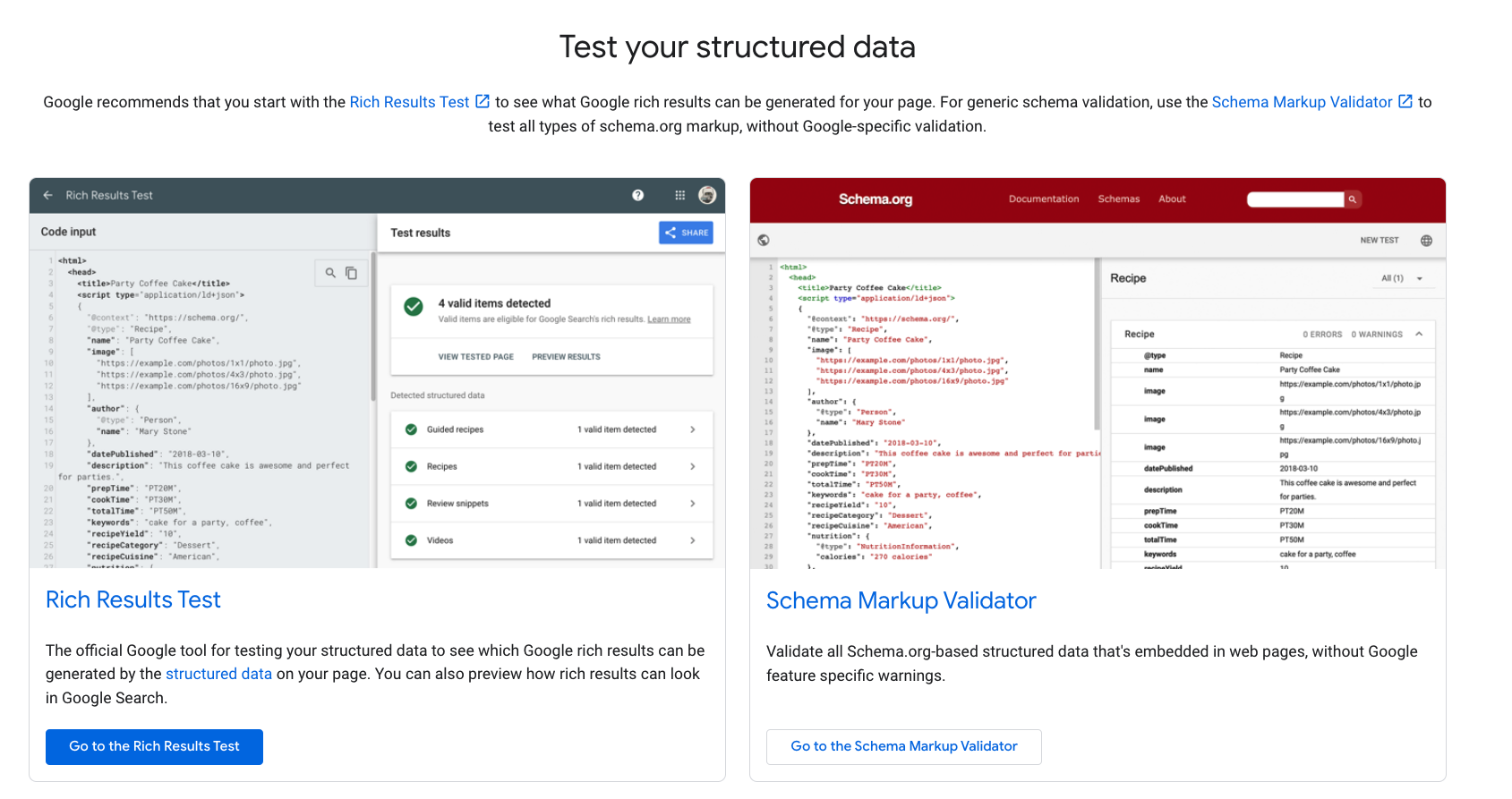
CRO & eCommerce SEO
We cannot stress the importance of CRO, or Conversion Rate Optimization, enough. Consider hiring a professional company that offers conversion rate services. This is an area where it really can be immensely beneficial to have a professional doing the work.
Utilizing analytical data, AB testing, video recordings of actual browser sessions, you can meticulously work to improve your conversion rate. Simple changes include changing CTA text and button color, but true CRO is so much more than that and requires a skilled professional with an analytical mind. CRO is one of the easiest ways to boost your online sales numbers!
Leverage Product Video and YouTube
Earlier we discussed how to write unique & engaging product descriptions. Including videos on product pages is a great way to be more engaging, especially if they are unique and original videos and not borrowed from the manufacturer.
Remember, site speed and technical optimization tactics! Make sure that your videos don’t bog down your product pages. You can try tricks such as ensuring all important elements on the page load before the video loads so that your users can still view the page without having to wait on the video to load.
You can choose to host your videos or embed YouTube videos. The advantage of embedding YouTube videos is YouTube can become a marketing tool of its own if you are willing to invest in resources for high-quality video production.
Technical SEO & eCommerce
Technical SEO is important no matter what type of website you own, but for eCommerce, technical optimizations are even more important. For one, your average eCommerce page often has thousands of products and dozens of categories/subcategories, so advanced tactics like these are often time-consuming, complicated, and require skilled (expensive) web development labor. In other words, there are often a lot more dynamically-generated pages to eCommerce websites, meaning there are potentially many more technical issues to worry about. And yet, these technical aspects of SEO are too often neglected by some of the biggest online retailers.
An eCommerce website’s backlink profile usually points to a few select pages, the homepage, a few popular products and categories, but many pages will have no backlinks and little authority on their own. In these cases, having better technical SEO optimizations in place can help you win the “SEO race” against your competition.
The key to keeping your website optimized from a technical perspective is to run a technical SEO audit every month or so, depending on how frequently the website is updated. If new functionality or additional page types are routinely added, you’ll need to complete this process more frequently.
Popular SEO Audit Tools:
Screaming Frog is a crawler that mimics how search engine bots crawl your site. After crawling your site, Screaming Frog compiles this information into a user-friendly interface. However, like other tools on the list, it relies more on the users’ knowledge for insights, whereas Ahrefs and SEMRush have site audit software that offers insight and suggested changes based on its crawl.
Ahrefs and Other Website Audit Tools
Ahrefs and similar tools like SEMRush will crawl your site and evaluate your SEO efforts. They can crawl your site on a daily or weekly basis to monitor changes. With each crawl, you’ll get an overview screen with the overall health and metrics of your site based on the crawl.

Example of Ahrefs Audit Issues
What’s great is that these tools will not just tell you what’s wrong, they’ll offer insight on how you might fix it, and why it’s an SEO issue.

Common Technical SEO Issues on eCommerce Websites Include:
- Too many pages: Get rid of unimportant pages that are diluting your domain authority. If a page isn’t getting significant traffic, consider removing the page and 301 redirecting to a better page. This can also affect site speed (see below).
- Duplicate Content: Duplicate content is a big SEO no-no and can hurt your eCommerce site’s ability to rank. If you have many pages using the same content, this can be a warning to Google that you are spammy. Block pages with duplicate content from being indexed in your robots.txt file, or use canonical tags when several pages share similar content. Say NO to duplicate content!
- Thin Content – Thin content is just as common an issue for eCommerce stores as duplicate content. It can be challenging to write unique, engaging, and substantive copy for thousands of product pages, but doing so sets your eCommerce store apart from Google and usually significantly improves conversion rate. Most eCommerce stores overlook this step, often relying on thin product descriptions from the manufacturer. This results in thin AND duplicate content!
- Site Speed – An increasingly important part of Google’s algorithm, the faster your website loads, the more “user-friendly” it is, and the more likely Google and other search engines are to send organic traffic your way! Use tools like Google’s Page Speed Insights tool or GTMetrix, which will analyze your store’s site speed and tell you what to do to improve it! Always be thinking of ways to improve your site speed and users and the search results pages will both thank you.
eCommerce SEO & Website Development
When building an eCommerce store from the ground up, it’s crucial to think about scalability. In other words, if you’re site is launching with only a few dozen products but plans on having several hundred or thousands on the same eCommerce platform, you will need to plan accordingly if you expect your website to be able to adapt and scale with you as you grow. Site structure decisions have huge eCommerce SEO implications.
This scalability has much to do with the eCommerce platform you pick, how you configure your website’s database and ERP, the hosting solution you choose, etc. You should certainly consult with an eCommerce consulting company before getting too far in the process unless you have the skills, time, and resources to make these types of essential and highly technical decisions on your own.
One primary goal of any eCommerce site should be to create low-resistant paths from the homepage to the checkout process. Theoretically, the average user on your website should have no problem browsing from the homepage to their desired products in just two or three clicks. Plan the user flow and strive to minimize the number of clicks it takes for a user to find their desired product(s). Optimize category pages for intuitive product sorting, filtering, and browsing. You also need to streamline the entire checkout process once a user has added a product to their shopping cart. In the same way that brick and mortar retail stores are designed to facilitate the purchasing of products every step of the way, your eCommerce store should do the same.
In addition to intelligent site structure and user-friendliness for humans, you also need to think about making the site easily navigable for search engine bots. This includes developing a sound URL structure that makes sense for search engine bots (and people) while being easy on the eyes.
Site structure strategies will vary from a web development perspective and will correlate with custom functionality and design requirements. Businesses should work with an eCommerce consultant before making site structure decisions.
For URL structure:
- Be succinct
- Avoid keyword stuffing or being redundant
- Be descriptive and incorporate keywords in the URL slug if it makes sense. If your primary keyword for a category page is “red flannel hats”, consider making “red-flannel-hats” your URL slug.
Typical URL Structure for eCommerce category pages:
- https://www.example.com/category/hats/red/flannel
- https://www.example.com/c/hats/red-flannel-hats
Bad URL Structure for eCommerce category pages:
- https://www.example.com/category/hats/red-hats
- https://www.example.com/category/hats/colored-hats/red/hats
- https://www.example.com/category/h/c-h/r/h-rf-h
Good URL structure for Products
- https://www.example.com/products/golf/drivers/titliest/917d2
- https://www.example.com/p/golf/drivers/titlesist/titlesist-917d2-driver
Bad URL Structure for Products
- https://www.example.com/products/golf/product/golf-product1234.html
- https://www.example.com/p/golf/drivers/t/234
- https://www.example.com/cart/item43
Review the SERPs (search engine results pages) for similar types of products and categories
Note how the top ranking websites are structuring category page and product page URLs, and emulate them with an improved twist, if possible.
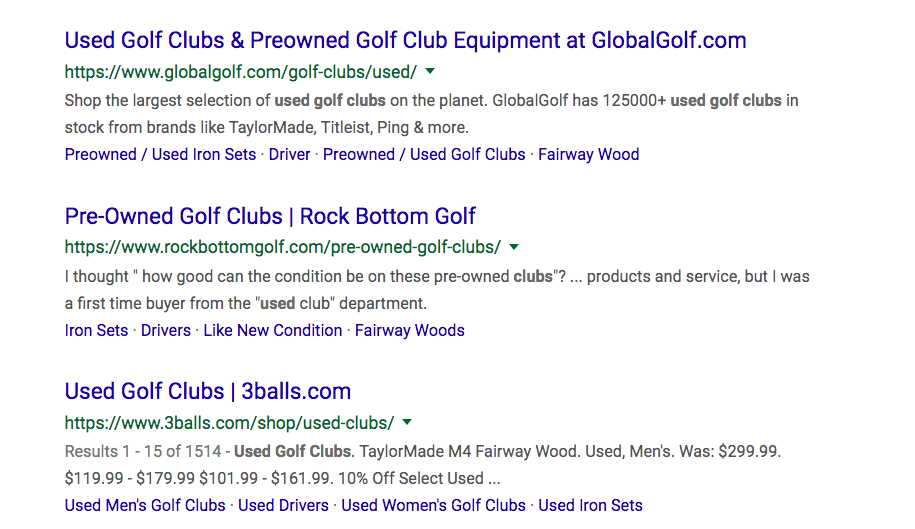
Note that even though the top ranking websites all structure their URLs differently, they’re all strategically structured to convey what the page is about to help search engines better understand their pages.
Develop Custom Functionality From the Ground Up
When developing your eCommerce website, it’s essential to determine what types of functionality you’ll need from the website. Think about all of the custom functionality on an Amazon product page: related products, product reviews, customers who bought this item also bought this item, etc. All of this functionality is great for an eCommerce website, and Amazon can be a great company to study in this regard.
But if you expect your eCommerce website to have robust functionality, you often need to build it from the ground up to be as successful as possible. The reason is that since site speed and organization of source code affect your SEO, you want any custom development work to be built in so that everything works harmoniously and site speed is as quick as possible.
For example, many WooCommerce WordPress eCommerce stores rely on an assortment of different plugins to drive functionality, which can end up causing many headaches and technical SEO issues down the road. Because many of these plugins are developed independently, they don’t always work seamlessly together.
Furthermore, anytime a plugin update is released, it may potentially disrupt others from functioning correctly, and you might not realize your website is broken until irritated customers are contacting you for refunds. This can end up costing more money if you need to hire an eCommerce development company to help you update plugins to prevent technical SEO issues that can wreak havoc on your search results.
Therefore, when building an eCommerce website, consider all the functionality that you will need and work with a company that can develop your website to work how you want it from the ground up. Build your website in a way that adding functionality in the future is as simple as possible.
Homepage to Checkout: Carve the Path of Least Resistance
When building your website, focus on making it as easy as possible for a shopper to arrive at your homepage, find the product(s) they are looking for, and complete the checkout process. You must create a website that makes this path as easy as possible to increase conversions. If you have historical data, AB tests, CRO data, etc., use it to build a website that converts as many browsers into shoppers as possible.
- Minimize clicks from homepage to product page and checkouts
- Have “add to cart” throughout the product page
- Have links to easy, streamlined, checkout processes for shoppers in a hurry.
- Don’t require users to sign in or create an account to make a purchase
- Have a company that specializes in CRO and eCommerce consult you throughout your design and eCommerce web development processes.
Mobile Optimization Across Devices
Optimizing your website for mobile devices has become increasingly important every year for over a decade. If you run an eCommerce store, you need to prioritize the mobile experience over the desktop experience. This means creating a responsive website that caters to the size of the device accessing it.
For several years, Google has told us that they are switching to the mobile-first index, which greatly impacts eCommerce SEO strategies. If Google is prioritizing the mobile experience, it behooves your eCommerce store to do so as well.
This means that when Google makes their website rankings, they pay more attention to your mobile site than your desktop site. Since the majority of eCommerce shoppers either start or finish their purchase online, you MUST focus on the mobile experience. Mobile usability and site speed are as important, if not more important, than desktop usability and site speed.
A good place to start is by plugging your site into Google’s Mobile-Friendly tester tool.
Link Earning & Link Building for eCommerce SEO
In 2025, links remain one of the most important trust signals that search engines like Google use to evaluate your domain’s authority and determine eCommerce website rankings.
If you’re new to link building in general, Moz.com’s beginner’s guide to link building is a fantastic place to start.
There are many ways to build links. In the old days of SEO, submitting your website to directories and things of that nature was enough to set you apart from the competition. Today, it is not, and Google doesn’t pay much attention to the links coming from low-quality directories.
Instead, focus on earning links instead of building links to your eCommerce store. In other words, create “linkbait.” Create content on your website that entices people to link to it.
Here are some of the most effective link building or earning methods to gain relevant, authoritative external backlinks web that point to your eCommerce site:
- Content-based (develop an infographic, white paper, how-to-guide, image gallery, or blog article that offers engaging and quality information on a topic.)
- Guest blogging (not as effective as it once was, but the content and guest blogging domain is of quality, guest blogging remains an excellent method for building links.
- Ego bait (create a piece of content designed to inflate the ego of someone with some authority, knowing they will share the content with their professional circle and natural links will occur as a result)
- Broken link building (find broken links to competitor sites using a tool like Ahrefs.com, and reach out to the linking webmaster(s) to ask if they will replace their broken link to a better page on your domain. You may have to create a resource or blog post page if you don’t have an existing resource. Make sure your content is of higher quality than the original link.
- Link reclamation (find broken links/404s on your site with a tool like Ahrefs.com and implement 301 redirects to resolve the broken links on an existing page. This will help preserve the link “juice.” This is a great example of a basic technical SEO tactic that is an effective link building tactic.
Properly Manage Out-of-Stock Products
Never simply delete a product (or category, for that matter) from your website. There are several strategies to consider, but none of them involve simply deleting the old page. Here are some options to consider, which depend on the circumstances at hand.
- Leave the product page active and listed on the category page (and any subcategory pages), simply add a message that says the product is discontinued on the product page itself. Add links to relevant products within the old product pages on-page description.
- Take the old product page down, and implement a 301 redirect to the most relevant new page, whether a new similar product page, a blog post about the old product, a category page etc. Whatever is the most relevant page that can replace the old URL should be used.
Incentivize Customer Reviews & Engagement
Structured Data to display things like reviews in the SERPs is great and all, but if you have two reviews on your page that doesn’t look so great!
Create an incentivized program to encourage your users to leave reviews. This strategy should extend beyond reviews, as you should prioritize engaging your past, present, and future customers as much as possible. In the eCommerce game, repeat customers are hugely beneficial, and online customers respond to incentivization.
Increase eCommerce Site Speed & Decrease Page Load Times
An increasingly important part of Google’s algorithm, having a fast website will improve your rankings and user experience drastically.
Your focus should be on user experience, but you need to consider that how quickly your site loads is part of that experience. Take steps towards becoming the fastest website among your competitors. In this regard, you don’t have to be lightning-fast if you are serving your content faster than the competitors within your niche or industry.
Make sure your images are properly compressed for use on the web, or big image files could be bogging your site down. Also be on the lookout for CMS that may be forcing larger versions of product images when compressed versions would suffice (Looking at you, Magento!)
Site Speed Tools:
Google’s PageSpeed Insights (insight into Google’s perspective)
GTMetrix (insight into Google, Bing, and Yahoo)


